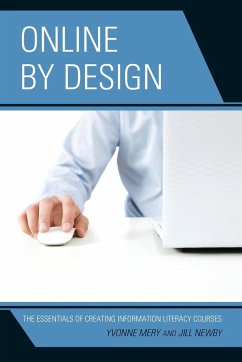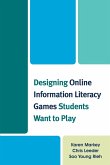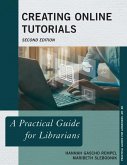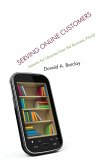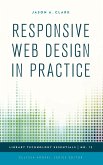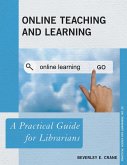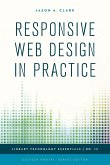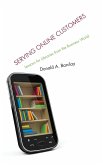- Broschiertes Buch
- Merkliste
- Auf die Merkliste
- Bewerten Bewerten
- Teilen
- Produkt teilen
- Produkterinnerung
- Produkterinnerung
As online instruction becomes more popular, librarians will want to develop the knowledge and skills needed to create an effective online information literacy course. Online by Design: The Essentials of Creating Information Literacy Courses will guide librarians as they go through the process of designing, developing, and delivering online information literacy courses. Yvonne Mery & Jill Newby offer proven techniques and tips for creating quality online courses that are engaging and effective. This handbook is perfect for instruction librarians who are interesting in developing new courses or refreshing existing ones.…mehr
Andere Kunden interessierten sich auch für
![Designing Online Information Literacy Games Students Want to Play Designing Online Information Literacy Games Students Want to Play]() Karen MarkeyDesigning Online Information Literacy Games Students Want to Play106,99 €
Karen MarkeyDesigning Online Information Literacy Games Students Want to Play106,99 €![Creating Online Tutorials Creating Online Tutorials]() Hannah Gascho RempelCreating Online Tutorials67,99 €
Hannah Gascho RempelCreating Online Tutorials67,99 €![Serving Online Customers Serving Online Customers]() Donald A. BarclayServing Online Customers81,99 €
Donald A. BarclayServing Online Customers81,99 €![Responsive Web Design in Practice Responsive Web Design in Practice]() Jason A. ClarkResponsive Web Design in Practice111,99 €
Jason A. ClarkResponsive Web Design in Practice111,99 €![Online Teaching and Learning Online Teaching and Learning]() Beverley E. CraneOnline Teaching and Learning86,99 €
Beverley E. CraneOnline Teaching and Learning86,99 €![Responsive Web Design in Practice Responsive Web Design in Practice]() Jason A. ClarkResponsive Web Design in Practice61,99 €
Jason A. ClarkResponsive Web Design in Practice61,99 €![Serving Online Customers Serving Online Customers]() Donald A. BarclayServing Online Customers138,99 €
Donald A. BarclayServing Online Customers138,99 €-
-
-
As online instruction becomes more popular, librarians will want to develop the knowledge and skills needed to create an effective online information literacy course. Online by Design: The Essentials of Creating Information Literacy Courses will guide librarians as they go through the process of designing, developing, and delivering online information literacy courses. Yvonne Mery & Jill Newby offer proven techniques and tips for creating quality online courses that are engaging and effective. This handbook is perfect for instruction librarians who are interesting in developing new courses or refreshing existing ones.
Produktdetails
- Produktdetails
- Verlag: Rowman & Littlefield Publishers
- Seitenzahl: 200
- Erscheinungstermin: 23. April 2014
- Englisch
- Abmessung: 229mm x 152mm x 11mm
- Gewicht: 298g
- ISBN-13: 9780810891111
- ISBN-10: 0810891115
- Artikelnr.: 40188203
- Herstellerkennzeichnung
- Libri GmbH
- Europaallee 1
- 36244 Bad Hersfeld
- gpsr@libri.de
- Verlag: Rowman & Littlefield Publishers
- Seitenzahl: 200
- Erscheinungstermin: 23. April 2014
- Englisch
- Abmessung: 229mm x 152mm x 11mm
- Gewicht: 298g
- ISBN-13: 9780810891111
- ISBN-10: 0810891115
- Artikelnr.: 40188203
- Herstellerkennzeichnung
- Libri GmbH
- Europaallee 1
- 36244 Bad Hersfeld
- gpsr@libri.de
Yvonne Mery is associate librarian and instructional designer at the University of Arizona. She has co-authored several papers on the integration of information literacy in online classes and presented at numerous national conferences on best practices for online information literacy instruction.
List of Illustrations
List of Tables
Foreword
Preface
Acknowledgments
Chapter 1: Introduction
Perceptions of Online Learning
Perceptions of IL Credit Courses
Is Online Instruction Effective?
Benefits of Online Instruction for Students, Librarians, and Libraries
The Challenges of Online Instruction
Defining Online Instruction
SECTION 1: DEVELOPING THE COURSE
Chapter 2: The Nuts and Bolts of Online Credit Courses: What You Need to
Know Before You Start
The Course Approval Process
Online Instructor Roles
Competencies
Time Commitment
Marketing the Course
The CMS: A Love/Hate Relationship
Quality Matters!
Where to Get Training
Chapter 3: A Recipe for Success: Cooking up the Curriculum
Needs Assessment and Environmental Scanning
Writing Goals and Outcomes
Information Literacy Topics in an Online Course
Course Units: Scope and Sequence
Textbooks
Resource 3.1: Sample Undergraduate Course Topics and Learning Outcomes
Resource 3.2: Sample Graduate Course Topics and Learning Outcomes
Chapter 4: Creating a Student-Centered Syllabus: Taking it to the Next
Level
The Interactive Syllabus
What is a Syllabus Good for Anyway?
Elements of the Course Syllabus
Will They Use It?
Resource 4.1: Sample Syllabus Undergraduate Information Literacy Course
Resource 4.2: Sample Syllabus Graduate Information Literacy Course
SECTION 2: DEVELOPING THE UNITS
Chapter 5: Learning Materials 101: Variety is the Spice of Life
Underlying Teaching Strategies
Aligning Learning Materials and with Learning Objectives
Addressing Learning Styles
Creating the Materials
Universal Design for Learning
Using Copyrighted Materials
Chapter 6: Tutorials 101: Keeping Students Engaged
Passive and Active Learning
Writing Student Learning Outcomes
Building Interactivity
Building Engagement
Make it Real
Make it Effective
Choosing the Software
Developing for Mobile
Chapter 7: Assignments 101: Making it Real, Related, and Rewarding
Assignments: More than Busy Work
Creating Meaningful Assignments
Best Practices in Assignment Development
Collaborative Assignments
Workload Management
Resource 7.1: Sample Assignments for Graduate Students
Resource 7.2: Sample Assignment for Undergraduate Students
Chapter 8: But Did They Learn Anything? Assessing and Evaluating
The Assessment Cycle
Formative and Summative Assessment
Assessment Methods
A Word about Cheating
Evaluating Teaching Effectiveness
Resource 8.1: Pre-Post Test Questions
Resource 8.2: Research Portfolio Requirements
Chapter 9: New Models for Teaching and Learning
MOOCs
Digital Badges
The Flipped Classroom
Mobile
A New Instruction Librarian
Index
About the Authors
List of Tables
Foreword
Preface
Acknowledgments
Chapter 1: Introduction
Perceptions of Online Learning
Perceptions of IL Credit Courses
Is Online Instruction Effective?
Benefits of Online Instruction for Students, Librarians, and Libraries
The Challenges of Online Instruction
Defining Online Instruction
SECTION 1: DEVELOPING THE COURSE
Chapter 2: The Nuts and Bolts of Online Credit Courses: What You Need to
Know Before You Start
The Course Approval Process
Online Instructor Roles
Competencies
Time Commitment
Marketing the Course
The CMS: A Love/Hate Relationship
Quality Matters!
Where to Get Training
Chapter 3: A Recipe for Success: Cooking up the Curriculum
Needs Assessment and Environmental Scanning
Writing Goals and Outcomes
Information Literacy Topics in an Online Course
Course Units: Scope and Sequence
Textbooks
Resource 3.1: Sample Undergraduate Course Topics and Learning Outcomes
Resource 3.2: Sample Graduate Course Topics and Learning Outcomes
Chapter 4: Creating a Student-Centered Syllabus: Taking it to the Next
Level
The Interactive Syllabus
What is a Syllabus Good for Anyway?
Elements of the Course Syllabus
Will They Use It?
Resource 4.1: Sample Syllabus Undergraduate Information Literacy Course
Resource 4.2: Sample Syllabus Graduate Information Literacy Course
SECTION 2: DEVELOPING THE UNITS
Chapter 5: Learning Materials 101: Variety is the Spice of Life
Underlying Teaching Strategies
Aligning Learning Materials and with Learning Objectives
Addressing Learning Styles
Creating the Materials
Universal Design for Learning
Using Copyrighted Materials
Chapter 6: Tutorials 101: Keeping Students Engaged
Passive and Active Learning
Writing Student Learning Outcomes
Building Interactivity
Building Engagement
Make it Real
Make it Effective
Choosing the Software
Developing for Mobile
Chapter 7: Assignments 101: Making it Real, Related, and Rewarding
Assignments: More than Busy Work
Creating Meaningful Assignments
Best Practices in Assignment Development
Collaborative Assignments
Workload Management
Resource 7.1: Sample Assignments for Graduate Students
Resource 7.2: Sample Assignment for Undergraduate Students
Chapter 8: But Did They Learn Anything? Assessing and Evaluating
The Assessment Cycle
Formative and Summative Assessment
Assessment Methods
A Word about Cheating
Evaluating Teaching Effectiveness
Resource 8.1: Pre-Post Test Questions
Resource 8.2: Research Portfolio Requirements
Chapter 9: New Models for Teaching and Learning
MOOCs
Digital Badges
The Flipped Classroom
Mobile
A New Instruction Librarian
Index
About the Authors
List of Illustrations
List of Tables
Foreword
Preface
Acknowledgments
Chapter 1: Introduction
Perceptions of Online Learning
Perceptions of IL Credit Courses
Is Online Instruction Effective?
Benefits of Online Instruction for Students, Librarians, and Libraries
The Challenges of Online Instruction
Defining Online Instruction
SECTION 1: DEVELOPING THE COURSE
Chapter 2: The Nuts and Bolts of Online Credit Courses: What You Need to
Know Before You Start
The Course Approval Process
Online Instructor Roles
Competencies
Time Commitment
Marketing the Course
The CMS: A Love/Hate Relationship
Quality Matters!
Where to Get Training
Chapter 3: A Recipe for Success: Cooking up the Curriculum
Needs Assessment and Environmental Scanning
Writing Goals and Outcomes
Information Literacy Topics in an Online Course
Course Units: Scope and Sequence
Textbooks
Resource 3.1: Sample Undergraduate Course Topics and Learning Outcomes
Resource 3.2: Sample Graduate Course Topics and Learning Outcomes
Chapter 4: Creating a Student-Centered Syllabus: Taking it to the Next
Level
The Interactive Syllabus
What is a Syllabus Good for Anyway?
Elements of the Course Syllabus
Will They Use It?
Resource 4.1: Sample Syllabus Undergraduate Information Literacy Course
Resource 4.2: Sample Syllabus Graduate Information Literacy Course
SECTION 2: DEVELOPING THE UNITS
Chapter 5: Learning Materials 101: Variety is the Spice of Life
Underlying Teaching Strategies
Aligning Learning Materials and with Learning Objectives
Addressing Learning Styles
Creating the Materials
Universal Design for Learning
Using Copyrighted Materials
Chapter 6: Tutorials 101: Keeping Students Engaged
Passive and Active Learning
Writing Student Learning Outcomes
Building Interactivity
Building Engagement
Make it Real
Make it Effective
Choosing the Software
Developing for Mobile
Chapter 7: Assignments 101: Making it Real, Related, and Rewarding
Assignments: More than Busy Work
Creating Meaningful Assignments
Best Practices in Assignment Development
Collaborative Assignments
Workload Management
Resource 7.1: Sample Assignments for Graduate Students
Resource 7.2: Sample Assignment for Undergraduate Students
Chapter 8: But Did They Learn Anything? Assessing and Evaluating
The Assessment Cycle
Formative and Summative Assessment
Assessment Methods
A Word about Cheating
Evaluating Teaching Effectiveness
Resource 8.1: Pre-Post Test Questions
Resource 8.2: Research Portfolio Requirements
Chapter 9: New Models for Teaching and Learning
MOOCs
Digital Badges
The Flipped Classroom
Mobile
A New Instruction Librarian
Index
About the Authors
List of Tables
Foreword
Preface
Acknowledgments
Chapter 1: Introduction
Perceptions of Online Learning
Perceptions of IL Credit Courses
Is Online Instruction Effective?
Benefits of Online Instruction for Students, Librarians, and Libraries
The Challenges of Online Instruction
Defining Online Instruction
SECTION 1: DEVELOPING THE COURSE
Chapter 2: The Nuts and Bolts of Online Credit Courses: What You Need to
Know Before You Start
The Course Approval Process
Online Instructor Roles
Competencies
Time Commitment
Marketing the Course
The CMS: A Love/Hate Relationship
Quality Matters!
Where to Get Training
Chapter 3: A Recipe for Success: Cooking up the Curriculum
Needs Assessment and Environmental Scanning
Writing Goals and Outcomes
Information Literacy Topics in an Online Course
Course Units: Scope and Sequence
Textbooks
Resource 3.1: Sample Undergraduate Course Topics and Learning Outcomes
Resource 3.2: Sample Graduate Course Topics and Learning Outcomes
Chapter 4: Creating a Student-Centered Syllabus: Taking it to the Next
Level
The Interactive Syllabus
What is a Syllabus Good for Anyway?
Elements of the Course Syllabus
Will They Use It?
Resource 4.1: Sample Syllabus Undergraduate Information Literacy Course
Resource 4.2: Sample Syllabus Graduate Information Literacy Course
SECTION 2: DEVELOPING THE UNITS
Chapter 5: Learning Materials 101: Variety is the Spice of Life
Underlying Teaching Strategies
Aligning Learning Materials and with Learning Objectives
Addressing Learning Styles
Creating the Materials
Universal Design for Learning
Using Copyrighted Materials
Chapter 6: Tutorials 101: Keeping Students Engaged
Passive and Active Learning
Writing Student Learning Outcomes
Building Interactivity
Building Engagement
Make it Real
Make it Effective
Choosing the Software
Developing for Mobile
Chapter 7: Assignments 101: Making it Real, Related, and Rewarding
Assignments: More than Busy Work
Creating Meaningful Assignments
Best Practices in Assignment Development
Collaborative Assignments
Workload Management
Resource 7.1: Sample Assignments for Graduate Students
Resource 7.2: Sample Assignment for Undergraduate Students
Chapter 8: But Did They Learn Anything? Assessing and Evaluating
The Assessment Cycle
Formative and Summative Assessment
Assessment Methods
A Word about Cheating
Evaluating Teaching Effectiveness
Resource 8.1: Pre-Post Test Questions
Resource 8.2: Research Portfolio Requirements
Chapter 9: New Models for Teaching and Learning
MOOCs
Digital Badges
The Flipped Classroom
Mobile
A New Instruction Librarian
Index
About the Authors

